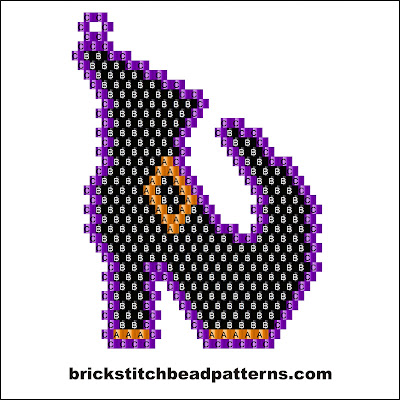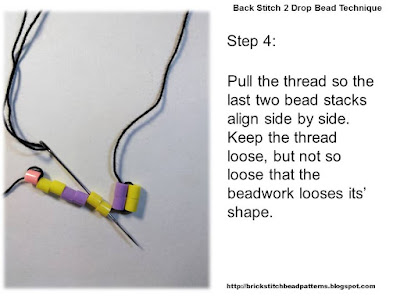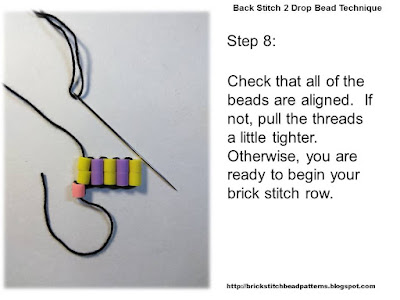Base Row Technique For Brick Stitch Beading
Brick stitch must have a foundation to build from. There are several ways to create a base row, also known as a foundation row, with beads. In this tutorial, you will see how to create a Two Row or/also known as a Peyote Start Base Row with a single bead technique to create the first row of your bead pattern. Beaders who are most familiar with the peyote stitch may find this technique more comfortable to use for their base rows. This beading technique can be done with just about any type and size of seed bead. However, disk beads, beads with multiple holes, and triangular beads are not recommended with this stitch. Tube shaped beads, annular shaped beads (like Miyuki Delicas), barrel beads, cylinder shaped beads, crow beads, pony beads, and cube beads work well with the back stitch.
You can watch the following video or scroll down to see the individual slides of how to create a Two Row or Peyote Start base row for brick stitch beading with the single bead technique.
Watch the tutorial video:
You can view this video tutorial on YouTube here:
View the individual steps:
 |
| Two Row or Peyote Start Single Bead Base Row Tutorial |
The Two Row or Peyote Start Single Bead technique tutorial is part of an educational video series on brick stitch beading techniques. Scroll down to view each step. Click on the images to view them larger.
Step 1: String a stop bead at the end of your thread.
 |
| Two Row or Peyote Start Single Bead Base Row Tutorial Step 1 |
Step 2: String the first bead of your base row (pictured as yellow) and the last two beads of your second row (pictured as purple).
 |
| Two Row or Peyote Start Single Bead Base Row Tutorial Step 2 |
Step 3: Thread the needle down through the base row bead and pull the thread taught.
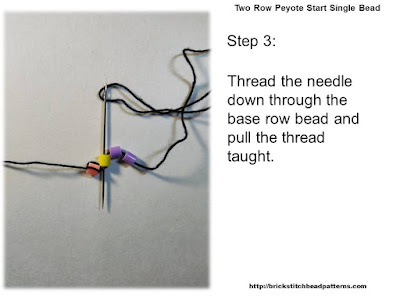 |
| Two Row or Peyote Start Single Bead Base Row Tutorial Step 3 |
Step 4: String the second bead of the base row.
 |
| Two Row or Peyote Start Single Bead Base Row Tutorial Step 4 |
Step 5: Thread the needle up through the second bead of the second row.
 |
| Two Row or Peyote Start Single Bead Base Row Tutorial Step 5 |
Step 6: String the third to last bead of the second row.
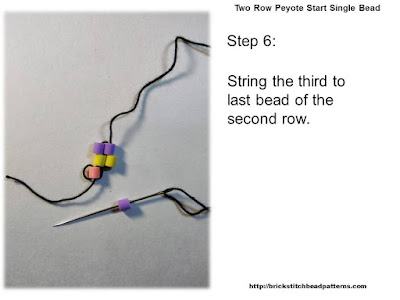 |
| Two Row or Peyote Start Single Bead Base Row Tutorial Step 6 |
Step 7: Thread the needle down through the second bead of the base row.
 |
| Two Row or Peyote Start Single Bead Base Row Tutorial Step 7 |
Step 8: String the next bead of your base row.
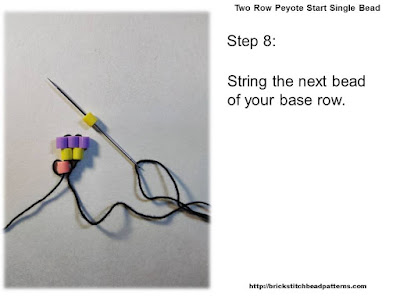 |
| Two Row or Peyote Start Single Bead Base Row Tutorial Step 8 |
Step 9: Thread the needle up through the last bead added to the second row.
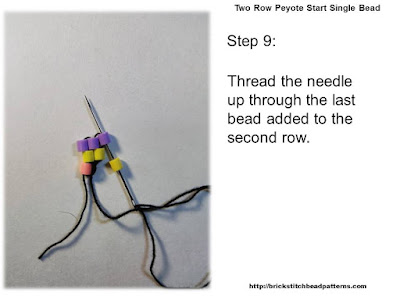 |
| Two Row or Peyote Start Single Bead Base Row Tutorial Step 9 |
Step 10: String the next bead of the second row.
 |
| Two Row or Peyote Start Single Bead Base Row Tutorial Step 10 |
Step 11: Thread the needle down through the last bead of the first row.
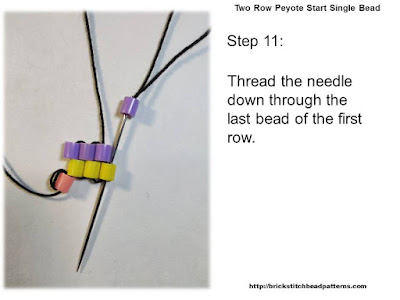 |
| Two Row or Peyote Start Single Bead Base Row Tutorial Step 11 |
Step 12: String the next bead of the first row.
 |
| Two Row or Peyote Start Single Bead Base Row Tutorial Step 12 |
Step 13: Thread the needle up through the last bead of the second row.
 |
| Two Row or Peyote Start Single Bead Base Row Tutorial Step 13 |
Step 14: String the next bead of the second row.
 |
| Two Row or Peyote Start Single Bead Base Row Tutorial Step 14 |
Step 15: Thread the needle down through the last bead of the first row.
 |
| Two Row or Peyote Start Single Bead Base Row Tutorial Step 15 |
Step 16: String the next bead of the first row.
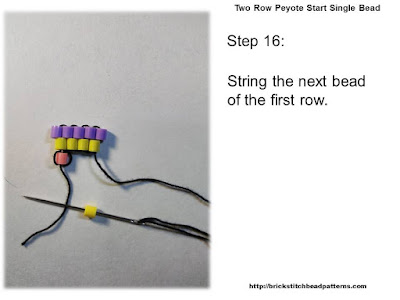 |
| Two Row or Peyote Start Single Bead Base Row Tutorial Step 16 |
Step 17: Thread the needle up through the last bead of the second row.
 |
| Two Row or Peyote Start Single Bead Base Row Tutorial Step 17 |
Step 18: If you have more beads to add to your rows, repeat from step #14.
 |
| Two Row or Peyote Start Single Bead Base Row Tutorial Step 18 |
More on Facebook:
Like Videos? Here are some tutorials from Brick Stitch Bead Patterns Journal on Facebook that will help you learn to brick stitch:
https://www.facebook.com/pg/brickstitchbeadpatterns/videos/?ref=page_internal
Like Videos? Here are some tutorials from Brick Stitch Bead Patterns Journal on Facebook that will help you learn to brick stitch:
https://www.facebook.com/pg/brickstitchbeadpatterns/videos/?ref=page_internal
Be sure to enter your email at right and subscribe to this blog or follow Brick Stitch Bead Patterns Journal on Facebook. Also, share, share, and share alike!
Follow Brick Stitch Bead Patterns Journal on Social Media:
Twitter: https://twitter.com/BrickStitchBead
YouTube: Brick Stitch Bead Patterns Journal
Instagram: https://www.instagram.com/brickstitchbeadpatterns/ (@brickstitchbeadpatterns)









